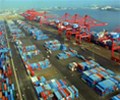

What began as a crippling year as trade tariffs and the COVID-19 pandemic torpedoed imports and exports through the Port of Long Beach (POLB) and the Port of Los Angeles (POLA), the twin ports of San Pedro Bay, California, turned out to be a record-breaker by year’s end with another boom fiscal year expected to follow in 2021.
“The Covid lockdown changed everything,” Mario Cordero, executive director of the Port of Long Beach, told Xinhua in an exclusive interview Friday. “When people weren’t able to shop in stores, consumer buying habits changed overnight, causing a surge in online buying and eCommerce. That means more shipping …”
That consumer trend moved the twin ports into top slots nationwide in TEU volume, as shipping of household goods and consumer products to and from Pacific countries and the United States soared.
A TEU, short for “twenty-foot equivalent unit,” is a measurement commonly used in the shipping industry that refers to the capacity of 20-foot-long steel shipping containers used to carry goods globally.
After shipping rates tumbled early in the year when the pandemic first struck, both Southern California ports rebounded with a vengeance to reach a 2020 volume of 8,113,315 TEUs for the POLB, ranking it at the third place for U.S. ports, and 9,213,395.95 TEUs for the POLA, snagging the coveted No.1 slot. 2020 marked a record-breaking year for both.
“Our record-breaking year was due to the dedication of the men and women who work on waterfront (categorized as essential workers by the government) who continued work every day during lockdown to keep the ports operating while everyone else was sheltering in place,” said Cordero gratefully.
Early this month, POLA’s Board of Harbor Commissioners approved a 1.7 billion U.S. dollars annual budget, anticipating that their dockworkers and terminal operators would move approximately 9.7 million TEUs, while the Long Beach Board of Harbor Commissioners submitted an annual budget for the POLB of 622.4 million U.S. dollars, anticipating another banner year ahead.
“Although the COVID-19 pandemic tested our resolve, we remain focused on the future by investing in strategic projects that will improve cargo flow, reliability and efficiency,” Harbor Commission President Frank Colonna said in a statement. “As an international gateway for trade, the port is well positioned to endure economic challenges and assist in the nation’s economic recovery.”
The POLB largest revenues in last fiscal year ended this March, 395 million U.S. dollars, were generated by shipping services and container terminals, with an additional 36 million U.S. dollars from dry bulk terminals, and an anticipated 16 million U.S. dollars from real estate deals in land and building rentals.
The POLB currently focused on expansion to meet the unprecedented demand in the 2021 to 2022 fiscal year. Due to high revenues from rail activities, Cordero told Xinhua that improving rail access and services at the POLB was one of their top priorities.
“Rail is a big emphasis for us, since more than 50 percent of our revenue is generated from rail-related activities,” Cordero asserted.
Pier B on-dock rail support facility construction will tap 54 million U.S. dollars of the 77 million U.S. dollars allocated to rail improvements. Construction will expand the Pier B Rail Yard from 10 to 44 tracks, which will include 39 storage tracks and five 10,000-foot arrival and departure tracks to facilitate access and enhance services.
Terminal upgrades will be funded with 57 million U.S. dollars, much of which will be spent on the Pier G Wharf Improvement Project to construct approximately 240 feet of new wharf at the west end of Berth G236.
Other expenditures to be used to complete the Middle Harbor Redevelopment project combining Pier F and Pier E terminals into one advanced 304-acre terminal with an annual capacity of 3.3 million TEUs that can accommodate the world’s largest container vessels.
In total, the POLB will allocate approximately 329.1 million U.S. dollars to capital improvements and other infrastructure-related projects this year, such as modernizing rail, terminals, bridges, waterways, and other access routes, while benefits and salaries for 595 employees and 5 commissioners will claim 83 million U.S. dollars.
Over the next ten years, the POLB plans to invest up to 1.6 billion U.S. dollars in projects designed to improve marine terminal productivity and focus on green technology and other programs that will enhance the port’s sustainability and operational efficiency.
Cordero saw a positive future ahead with more record-breaking years to come. He attributed some of that to shifts in government policy and some to more localized manufacturing trends.
“The epicenter of manufacturing will continue to be China, but we may see more ‘near shoring.’” said Cordero.
Near shoring is manufacturing in the Western Hemisphere in places like Mexico or South America, which reduces transportation time to California ports.
Source: Xinhua